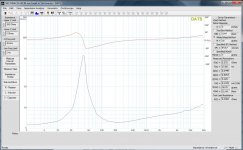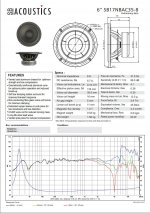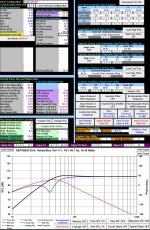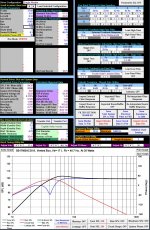I am having some problems with a pair of SB Acoustics SB17NBAC35-8 drivers.
They seem to be more than a little off factory specs.
Madisounds suggests a 17 litre box with a 2" diameter port 7" long for an F3 of ~44Hz.
This is a similar alignment to what others have used in other examples I have looked at using this woofer. It just doesn't seem to work out with the TS parameters I get off the driver with DATS V2.
Compare the results to the SB Acoustics spec sheet.
Here are two versions of Jeff Bagbys Woofer box Model and Circuit Designer spreadsheet,
First spreadsheet with spec sheet data
Second spreadsheet with DATS V2 measured data
Biggest T/S differences,
spec, factory, measured
FS, 31.5, 37.68
Qes, 0.38, 0.60
Qts, 0.35, 0.54
Vas, 45l, 21.4l
I re-calibrated the DATS v2, to make sure that wasn't the problem. I used the same 18g weight I always use.
I ran them for 1.5 hours with a 31Hz test tone before taking the measurements.
Can someone please point out my mistake, or have any ideas?
This doesn't make sense.
Thank you,
David.
They seem to be more than a little off factory specs.
Madisounds suggests a 17 litre box with a 2" diameter port 7" long for an F3 of ~44Hz.
This is a similar alignment to what others have used in other examples I have looked at using this woofer. It just doesn't seem to work out with the TS parameters I get off the driver with DATS V2.
Compare the results to the SB Acoustics spec sheet.
Here are two versions of Jeff Bagbys Woofer box Model and Circuit Designer spreadsheet,
First spreadsheet with spec sheet data
Second spreadsheet with DATS V2 measured data
Biggest T/S differences,
spec, factory, measured
FS, 31.5, 37.68
Qes, 0.38, 0.60
Qts, 0.35, 0.54
Vas, 45l, 21.4l
I re-calibrated the DATS v2, to make sure that wasn't the problem. I used the same 18g weight I always use.
I ran them for 1.5 hours with a 31Hz test tone before taking the measurements.
Can someone please point out my mistake, or have any ideas?
This doesn't make sense.
Thank you,
David.
Attachments
Check the impedance response, there are the T/S specs, yours are not far off unlike the manufacturer's data:
SB Acoustics SB17NBAC35-8 | HiFiCompass
SB Acoustics SB17NBAC35-8 | HiFiCompass
Can someone please point out my mistake, or have any ideas?
This doesn't make sense.
Thank you,
David.
It makes perfect sense, and this is reality. Both of the tsp versions, factory and yours measured by dats, have got a similar alignment goal, and that is 40 litres vented. You can make listening trials with/without vent plugs and experiment placing speakers. Often have I experienced the same or worse.
It makes perfect sense, and this is reality. Both of the tsp versions, factory and yours measured by dats, have got a similar alignment goal, and that is 40 litres vented.
The manufacturer data suggest a 30 liter vented, but the OP's data suggest a 60 liter box for the same standard (flat as possible) vented alignment. Simulated with Unibox.
Bottom line, it is not an issue! We are simply too spoiled, if we think otherwise.
That does not make any sense, there is a huge difference between a 30 litre and 60 litre box, not to mention how to size the vent.
Bottom line, it is not an issue! We are simply too spoiled, if we think otherwise.
I get it what you want to say, but if we don't see as a problem, then we may will never get a driver for our money as it is on the datasheet or at least close to it.
If you want to buy a woofer, what is the first thing that you check? The T/S parameters on the datasheet.
Last edited:
T/S parameters change with techniques and conditions.
You must determine the manufacturers methods before you judge their specs(or your equipment/method) as 'wrong'.
So: program, equipment,temperature,signal level, break-in for a start.
And just forget unibox when Qt gets out of the .3s
You must determine the manufacturers methods before you judge their specs(or your equipment/method) as 'wrong'.
So: program, equipment,temperature,signal level, break-in for a start.
And just forget unibox when Qt gets out of the .3s
Last edited:
try measure your nbac drivers with stepped sine at 1 to 2 volts, this will change the shape of driver impedance at resonance and thus the calculated parameters, try arta/limp
a quick chirp or mls stimuli will not measure high qms drivers accurately
a quick chirp or mls stimuli will not measure high qms drivers accurately
I got similar impedance and free-air properties with a pair of SB17CAC35-4 I just bought a few weeks ago. These drivers are very similar to the NBAC35, except the cone has been deeply anodized to create a ceramic layer on the inner and outer surface. I was using DATS. I got an Fs of about 40 hz, and Qts of about .5 (I don't have my notes in front of me). I did not measure Vas.
Both units were very consistent with each other. Basically there was no meaningful difference between them in impedance, Qts, Fs, Frequency response, harmonic distortion, or the frequency of the first cone break up mode (9.8kHz).
Since I am using these drivers in a sealed box as midrange drivers above 160 Hz, I am not concerned about the variation from spec in Fs and Q.
Celef may be right about the drive level. Yeas ago Morel started publishing two sets of T/S parameters, one for small signal, and one for 1 V RMS. The 1 V measurements tend to have lower Fs, lower Q, and higher Vas compared to the small signal measurements. This matches theory.
So perhaps SB is measuring these drivers with a "large" signal, which would be more realistic. DATS is using a fairly small signal.
Both units were very consistent with each other. Basically there was no meaningful difference between them in impedance, Qts, Fs, Frequency response, harmonic distortion, or the frequency of the first cone break up mode (9.8kHz).
Since I am using these drivers in a sealed box as midrange drivers above 160 Hz, I am not concerned about the variation from spec in Fs and Q.
Celef may be right about the drive level. Yeas ago Morel started publishing two sets of T/S parameters, one for small signal, and one for 1 V RMS. The 1 V measurements tend to have lower Fs, lower Q, and higher Vas compared to the small signal measurements. This matches theory.
So perhaps SB is measuring these drivers with a "large" signal, which would be more realistic. DATS is using a fairly small signal.
David,I ran them for 1.5 hours with a 31Hz test tone before taking the measurements.
Can someone please point out my mistake, or have any ideas?
I'd guess you didn't push the suspension very hard with your test.
To loosen the suspension, lowering Fs and raising Vas, "excercise" the speaker by pushing it forward and back (carefully) well past Xmax (5.5mm, 11 peak to peak) by hand, using as many fingers to spread the force evenly.
Pushing the cones in and out a few times won't be enough to break them in. Right under the TS params they mention that measurements are done on broken in drivers. The surrounds right off the factory floor will be stiff and will loosen up after some use. Run them for several hours using a 20-25 Hz signal high enough to push them near to the extents of limits without bottoming. Make sure to prop them up enough to keep the openings in the magnets clear to avoid overheating the VC. Let them cool for a while before testing again. I guarantee you will see a significant change in parameters. Closer to the factory measurements but there will always be some difference because of tolerances.
TJ
TJ
So perhaps SB is measuring these drivers with a "large" signal, which would be more realistic. DATS is using a fairly small signal.
i think sb uses constant voltage measurement at 1 volt.
the new dats is said to have an increased output level, but i have not seen any number, the stimuli seems to be the same
Sadly Zilch is no longer with us to sort things like this out.
Another measurement kind of guy is...
SBAcoustics-3WC
Might want to look there.
Another measurement kind of guy is...
SBAcoustics-3WC
Might want to look there.
The German magazine Hobby Hifi measured this woofer one year ago.
Inhalt HOBBY HiFi 06/18
The results:
Re= 5,6 Ohm
Le= 0,17 mH
Fs = 29 Hz
Qms = 5,6
Qes = 0,44
Qts = 0,41
Sd = 127 qcm
VAS = 45 liters
MMS = 0,5 kg/s
Enclosure:
45 ltr. Bassreflex
Port ø 70mm, 270 mm long
- 3dB: 24 Hz
17 ltr. sealed
560 mF capacitor (GHP)
- 3 dB: 36 Hz.
Best regards
Ludger
Inhalt HOBBY HiFi 06/18
The results:
Re= 5,6 Ohm
Le= 0,17 mH
Fs = 29 Hz
Qms = 5,6
Qes = 0,44
Qts = 0,41
Sd = 127 qcm
VAS = 45 liters
MMS = 0,5 kg/s
Enclosure:
45 ltr. Bassreflex
Port ø 70mm, 270 mm long
- 3dB: 24 Hz
17 ltr. sealed
560 mF capacitor (GHP)
- 3 dB: 36 Hz.
Best regards
Ludger
Last edited:
I'm not sure what all the agonising is about here? 😀
20L box is usually about right for a 6" driver.
I suspect I could get almost any 6" driver doing OK in 20L.
Closed box, or reflex, or at a pinch reflex with a sock in the port. 😎
20L box is usually about right for a 6" driver.
I suspect I could get almost any 6" driver doing OK in 20L.
Closed box, or reflex, or at a pinch reflex with a sock in the port. 😎
yes that is max output.
It makes sense, really. This device is used to test any driver, including tweeters. If I am going to sweep a tweeter from 20 Hz to 20 kHz, I don't want more than about 0.2 V.
It makes sense, really. This device is used to test any driver, including tweeters. If I am going to sweep a tweeter from 20 Hz to 20 kHz, I don't want more than about 0.2 V.
I do not think a tweeter will take any harm with just one volt for measurement level
But that is not important, what is important is to know that drive level and stimuli will effect the results with some type of drivers and some stimulis are more accurate then others
But that is not important, what is important is to know that drive level and stimuli will effect the results with some type of drivers and some stimulis are more accurate then others
- Home
- Loudspeakers
- Multi-Way
- Are the SB17NBAC35-8 T/S specs way off?



